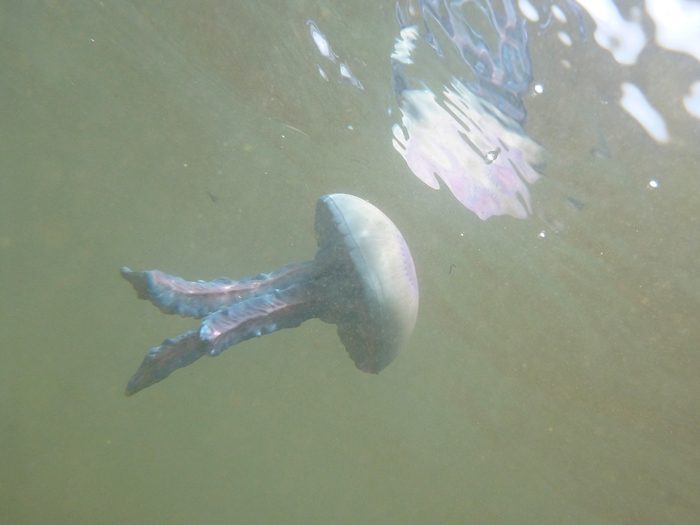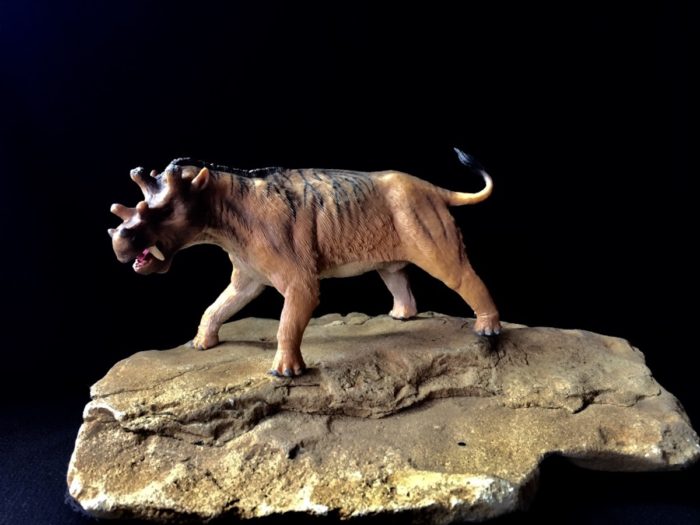Today I want you to introduce you to one of those creatures everybody knows, but knows almost nothing about, a jellyfish. Jellyfish are a very very old group of animals, they date back to the famous Ediacarian, more than 600 mya.
Age: Eocene
Review: Hyaenodon gigas(Wild Safari Prehistoric World by, Safari Ltd)
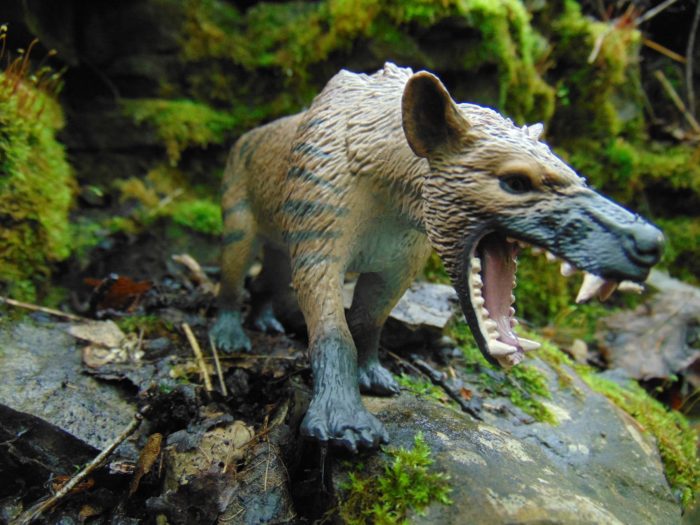
5 (11 votes)
For over 25 million years Hyaenodons hunted across Africa, Asia, North America and Europe. They were formidable predators that had oversized jaws. When hunting they would have probably ambush their prey with a quick rush, grab on to the head or neck with that impressive maw, and secure the kill.
Review: Uintatherium (Wild Safari Prehistoric World, by Safari Ltd.)
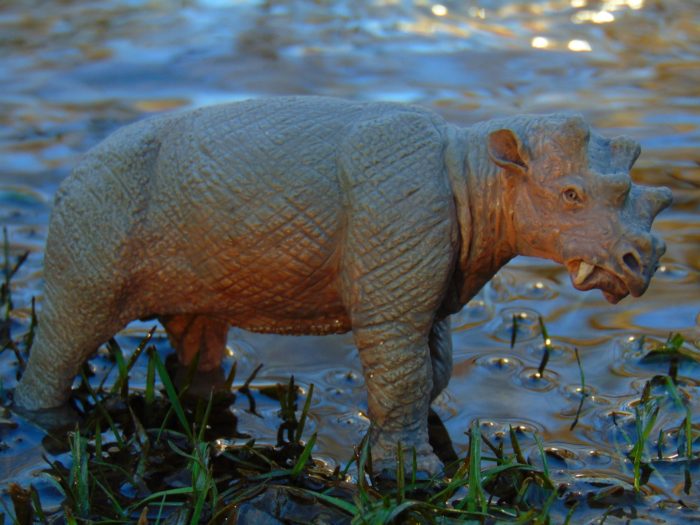
4.7 (17 votes)
Uintatherium was among the largest land animals in one of the stranger groups of large mammals that lived during the Eocene. Its flat and strongly built skull is quite the trophy as it is strange and bizarre. The skull is adorned with six long paired knobs that protruded from its nose, forehead, and from the back of its head.
Review: Megacerops (Wild Safari by Safari Ltd.)
Review: Uintatherium (CollectA)
Review: Prehistoric Mammal Skulls (Toob by Safari Ltd.)
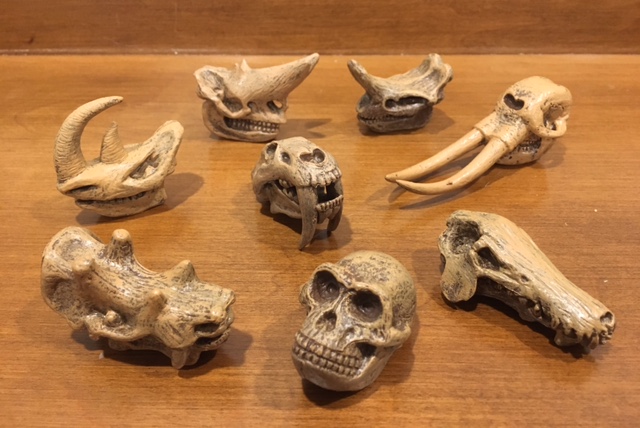
4.7 (9 votes)
Prehistoric skulls, be they those of dinosaurs, pterosaurs, sea monsters, mammals, amphibians, or any other beasts, are always things of beauty and intrigue. Let us take a look at this interesting variety of mammal skulls from Safari Ltd. There are eight in total, all coloured medium brown with a pale brown wash, and all with their names printed on the undersides.
Review: Megachoerus AKA Archaeotherium (Tyco)

4.2 (6 votes)
Review and photos by Archinto, edited by Suspsy
Here we will be taking a look at a classic rendition of the prehistoric mammal Archaeotherium, as perceived by the Tyco company in 1990 for their awesome Dino-Riders toy line. This particular figure was released for the Ice Age sub-theme (under the subgenus Megachoerus), which also featured a motorized woolly mammoth as well as an articulated Smilodon and Megatherium.
Here we will be taking a look at a classic rendition of the prehistoric mammal Archaeotherium, as perceived by the Tyco company in 1990 for their awesome Dino-Riders toy line. This particular figure was released for the Ice Age sub-theme (under the subgenus Megachoerus), which also featured a motorized woolly mammoth as well as an articulated Smilodon and Megatherium.
Review: Diatryma and Phorusrhacos (Starlux)
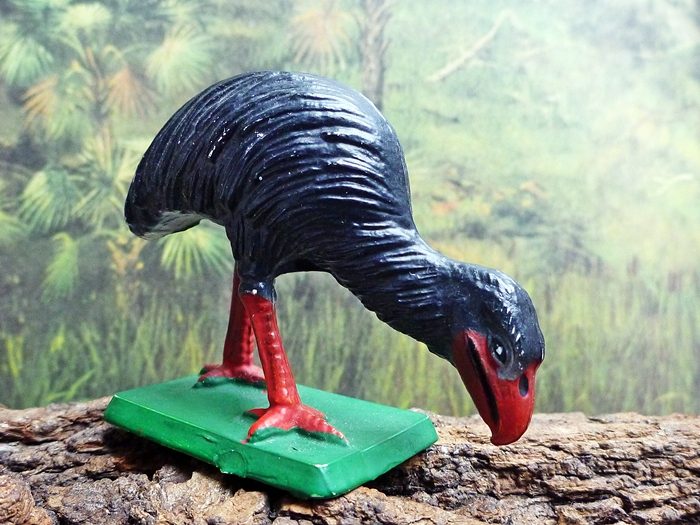
4.3 (9 votes)
Review and photos by Lanthanotus, edited by Suspsy
A few months ago I stumbled upon pictures of several dinosaur figures made by the French company Starlux while I was reading through the “Recent Acquisitions” thread in the DTF. I looked up this company and found that they had made a great array of dinosaurs as well as some very obscure and rarely depicted prehistoric animals.
A few months ago I stumbled upon pictures of several dinosaur figures made by the French company Starlux while I was reading through the “Recent Acquisitions” thread in the DTF. I looked up this company and found that they had made a great array of dinosaurs as well as some very obscure and rarely depicted prehistoric animals.
Review: Basilosaurus (Age of the Dinosaurs by PNSO)

4 (34 votes)
Review and photos by Bokisaurus, edited by Suspsy
Many millions of years ago, the vast Tethys Sea covered what would one day be the deserts of the Middle East and other large parts of the world. The demise of the mighty aquatic marine reptiles, along with the dinosaurs at the end of the Cretaceous opened up these vast oceans for a new cast of characters to take center stage and dominate.
Many millions of years ago, the vast Tethys Sea covered what would one day be the deserts of the Middle East and other large parts of the world. The demise of the mighty aquatic marine reptiles, along with the dinosaurs at the end of the Cretaceous opened up these vast oceans for a new cast of characters to take center stage and dominate.
Review: Andrewsarchus (CollectA)

4.6 (31 votes)
Andrewsarchus mongoliensis could be thought of as the mammalian equivalent of Spinosaurus in that it was a gigantic carnivore known only from scant remains. Namely, a single skull discovered in Mongolia by the legendary Roy Chapman Andrews in 1923. Once thought to have been a mesonychid, Andrewsarchus has since been determined to be an artiodactyl, and thus related to entelodonts, hippos, and whales.
Review: Embolotherium (Jurassic Hunters by Geoworld)

4.4 (8 votes)
Review and photographs by Indohyus, edited by Suspsy
By now, we are all aware of the reputation of the Geoworld Jurassic hunters line: cheaply made figures, full of inaccuracies despite (false) claims of palaeontological approval and shameless plagiarism of palaeoartists. However, I wanted to investigate these figures personally, so I got a figure from each of the first three ‘expeditions’ and see what they were like.
By now, we are all aware of the reputation of the Geoworld Jurassic hunters line: cheaply made figures, full of inaccuracies despite (false) claims of palaeontological approval and shameless plagiarism of palaeoartists. However, I wanted to investigate these figures personally, so I got a figure from each of the first three ‘expeditions’ and see what they were like.
Review: Moeritherium (Starlux)

4 (10 votes)
Review and photographs by Indohyus, edited by Suspsy
For many palaeontologists in my age group, the inspiration to become one came from watching the Jurassic Park movies and collecting the toy lines from them. I, on the other hand, became set on the idea from watching the Walking With .
For many palaeontologists in my age group, the inspiration to become one came from watching the Jurassic Park movies and collecting the toy lines from them. I, on the other hand, became set on the idea from watching the Walking With .

